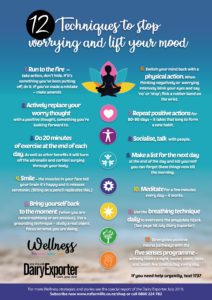Anne Lee
The amygdala hijack – it’s not a new action movie – but it could be going on in your head right now and making life feel like a bit of a battle.
Worry, anxiety, sleeplessness and feeling down are its modus operandi. Former top cop and police negotiator Lance Burdett has numerous tips to overpower the hijacker and shared them at farm investment and management company FarmRight’s annual conference last year, themed “Staying Sharp”.
Mental health change-maker Jimi Hunt, Highlanders personal development manager Mark Ranby, leadership coach Ngahi Bidois and mediator Paul Hutcheson also spoke to farm and corporate staff at the conference.
Burdett has been on both sides of the dark wall that is depression, anxiety and stress. In his previous job he regularly dealt with anger, sadness and violence – even tense hostage situations.
Time and time again he talked down those who were ready to end it all – then he found himself contemplating the same abyss. Coming through the mire was a tough journey but one that set him on a path to help others with his very special mix of skills. He now runs WARN International – WARN stands for wellness, awareness, resilience and negotiation.
 Burdett says the amygdala hijack results in a fight-or-flight response firing off in your brain and comes about because the amygdala has perceived a threat. As a part of the brain, the amygdala is wired to keep us from harm, he says, but in our modern world our brain perceives many stress triggers in the same way and floods our bodies with the stress hormones cortisol and adrenalin.
Burdett says the amygdala hijack results in a fight-or-flight response firing off in your brain and comes about because the amygdala has perceived a threat. As a part of the brain, the amygdala is wired to keep us from harm, he says, but in our modern world our brain perceives many stress triggers in the same way and floods our bodies with the stress hormones cortisol and adrenalin.
Panic attacks and anxiety can result. His advice, if in the throes of a panic attack, is to do the opposite to what the body is screaming at you to do.
“Do nothing. Stop, then fill your lungs with air and hold your breath for three seconds to stop your lungs from pumping – say something like slow is smooth, smooth is slow in your head while you’re holding your breath for those three seconds.
“Understand what you’re feeling is a physiological response, the threat is not real.”
Burdett says the good news is it’s possible to train the amygdala through a simple breathing technique not to react unnecessarily.
“So an extreme fight-or-flight response isn’t its first course of action.”
Sit quietly once-a-day and breath in for five seconds, hold it for five seconds and let it out for five seconds.
Repeat that three times in the one sitting – no more because you could put too much oxygen into your blood and induce anxiety symptoms.
“If you do this for 30 days, the research shows the amygdala response will reduce substantially.”
Burdett says contrary to what it may seem, men do feel the same emotions as women but have trained themselves, or been trained, not to express those emotions as openly.
“But that box men shut those emotions into – well it gets full.”
Learning how to share emotional thoughts, be vulnerable and open is important, so too is creating a safe environment and culture so those feelings can be shared.
“You are stronger than you think you are; you are better than you think you are. We’re all in this together – we’re all the same.
“Let’s start looking after ourselves, let’s start looking after each other – reach out if you need help.”
An appropriate touch on the arm and genuine, purposeful question asking how someone is doing or telling them you’re there for them creates a real sense of connection.
Burdett is a big advocate for hugs – albeit appropriate hugging.
“Men don’t hug enough – not this shoulder to shoulder thing – heart-to-heart.”
Huge advances have been made in the past five years in understanding how the brain works and techniques that can successfully lift mood and decrease anxiety, he says.
Hunt agrees but says a major factor in achieving wellness is taking that knowledge and acting on it. Depression isn’t there or not there – mental health is a continuum, he says.
People will slide up and down that continuum over their lifetime with 80% slipping to a level where they’re affected by poor mental health.
He shared his personal experience of sinking into depression and the tactics he took on the long journey back including building the world’s longest water slide to raise awareness of and get funding for mental health. (Check out the Live More Awesome Facebook page)
The first step is self-awareness – admitting there is a problem and then taking ownership of your healing.
“Your trauma is more than likely not your fault but your healing is 100% your responsibility.”
After several years of sadness and depression his climb back up the continuum eventually began when he was brutally honest with himself about the things he wanted to change and he began taking action using the many proven, researched tools repeatedly, in a disciplined way.
“Knowledge is useless without action.”
You can know that eating certain foods boosts feel-good chemicals in the brain, that meditation really does help but until you commit to them on a regular basis to form a habit and make the change that knowledge alone does no good.
You have to put yourself first to do that and it’s not selfish because the definition of selfish is putting yourself first to the detriment of others, he says.
“I’m asking you to put yourself first for the benefit of others.
“Only you can turn knowledge into action and turn action into change and then use that change to be the most awesome person you can.”
12 Techniques to stop worrying and lift your mood
- 1Run to the fire – take action, don’t hide. If it’s something you’ve been putting off, do it. If you’ve done something wrong – apologise, seek forgiveness.
- Actively replace your worry thought with a positive thought, something you’re looking forward to.
 Do 20 minutes of exercise a day. As well as other benefits it will burn off the adrenalin and cortisol surging through your body.
Do 20 minutes of exercise a day. As well as other benefits it will burn off the adrenalin and cortisol surging through your body.- Smile – the muscles in your face tell your brain it’s happy and it releases serotonin. (Biting on a pencil replicates this.)
- Bring yourself back to the moment (when you are catastrophising or are anxious). Use a grounding technique – study a real object, read two or three words.
- Switch your mind back with a physical action. When thinking negatively or worrying intensely blink your eyes and say ‘no’ or ‘stop’; flick a rubber band on the
wrist. - Repeat positive actions for 60-80 days – it takes that long to form a new habit.
- Socialise, talk with people.
- Make a list for the next day at the end of the day and tell yourself you can forget these things now till the morning.
- Meditate for a few minutes every day – it works.
- Use the breathing technique daily to overcome the amygdala hijack. (see story)
- Strengthen positive neural pathways with the five senses programme – actively notice a sight, sound, smell, taste and touch five times a day, every day.
- Download the poster of 12 Techniques to stop worrying and lift your mood from https://issuu.com/nzfarmlifemedia/docs/wellness_posterfinal?fr=sOTdlZDk5NTg Print it out and put it up in your tea room, share it on your farm app and chat about it with your staff.





